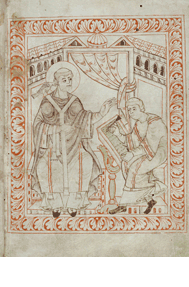INTRODUCTION
|
The fourteenth centenary of the death of Pope Gregory the Great (pontificate 590-604) was celebrated in 2004. Of the Roman popes he constitutes a figure of utmost importance. As the most significant writer of the High Middles Ages in Italy until the year 1000, he was at the centre of political affairs given his relations with Constantinople, the Visigoths, the Franks and, in particular, the Longobards. The greater part of his rich correspondence with Western and Eastern political and ecclesiastical figures has come down to us (more than 800 letters.) A master of the spiritual life and biblical exegesis, he wrote the earliest and most important biography of St. Benedict of Norcia and represents the beginning of the mediaeval period with the consolidation of Christianity among the European peoples, which his mission to England contributed to strengthening. Thirty-eight of the most important manuscripts in the textual history of Gregory the Greatís works, the history of Gregorian iconography, in particular, and mediaeval European illumination, in general, on loan from Italian and foreign libraries are on show in the exhibit organised by the National Committee for the Celebration of the XIV Centenary of the Death of Gregory the Great and Medici Laurentian Library, with the support of the Stiftsbibliothek of St. Galles. Critical, textual, and palaeographic considerations were the primary criteria adopted in the selection of the manuscripts, so as to present the most important codices of Gregorian work, such as codex B 159 sup. from the Ambrosian Library in Milan. Attention has been devoted, nevertheless, to both the earliest indirect tradition, documented by manuscript 220 from the Municipal Library in Amiens and manuscript 319 from the Municipal Library in Laon, and hagiographic biographies of the pope in codices 554 and 567 from the Stiftsbibliothek in St. Galles and manuscripts Lat. 10863 and Lat. 5670 from the National Library in Paris. Works of iconographic and decorative relevance are also presented beside those of purely significant textual and philological importance. In fact, the manuscripts of Gregory the Greatís works, which date from the period between the early Middle Ages and the late 15th century, reveal the evolution of the art of European illumination, from Merovingian Gaul to the renaissance centres patronised by Charlemagne, from the period of the Ottos through the Romanesque period to the flourishing of Italian Humanism. In many cases, these artefacts are true milestones in the art of the book, as exemplified by the ornamentation and celebrated historiated initials in manuscript 168 from the Municipal Library in Dijon. The exhibit is organised in two sections, both addressing philological, palaeographic, historical, and artistic aspects from an interdisciplinary perspective. The first is dedicated to Gregoryís works, including excerpts and abridgements; the second comprises Gregorian hagiographies. Within each section the manuscripts have been organised chronologically in order to allow the viewer to trace both the spread of Gregoryís works from the period immediately following his death up to the dawn of the Renaissance and the beginnings of the earliest biographies of the pope. The resulting overall image is one of a large fresco, in which the work of Gregory the Great appears clearly as one of the major vehicles of mediaeval Christian and Early Modern culture. The exposition project is made by Fabrizio Monaci - Roberta Paganucci
|


